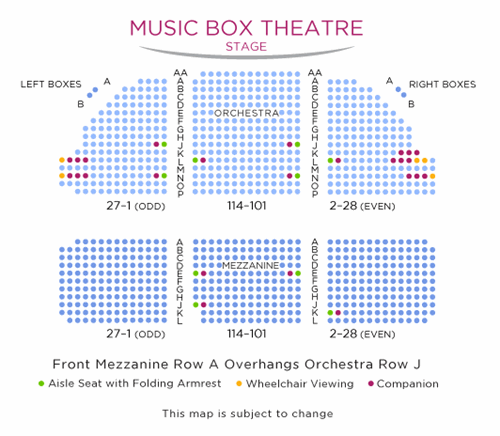






A world–famous children’s author under threat. A battle of wills in the wake of scandal. And one chance to make amends. Following an acclaimed West End run and three Olivier Awards, Giant tells the story of author Roald Dahl and the true scandal that shook his legacy.
Tony, Golden Globe, and Olivier Award-winner John Lithgow (Conclave, The Crown) reprises his extraordinary, career-defining performance as Roald Dahl. Written by Mark Rosenblatt, directed by Nicholas Hytner, and designed by Bob Crowley.
"Giant is all that theatre should be" - Daily Mail
"There is no more urgent play right now" – The Standard
"John Lithgow is mesmerising as Roald Dahl" – The Telegraph
Giant Broadway Show Tickets
HISTORY
Toward the close of 1919, the prominent theatrical producer Sam H. Harris made a proposition to his friend Irving Berlin: if the popular songwriter would devise a musical revue, Harris would find a theatre for it. Berlin responded with The Music Box Revue and in 1920 the Music Box Theatre was built to house the show. The Shuberts began acquiring shares of the venue from Harris in the 1920s. When Harris died in 1941, his wife sold half the shares in the theatre to the Shuberts, and half to Berlin. From that point on, Berlin and Shubert became equal partners in the ownership of the house. In 2007, the Berlin share of the theatre was sold to Shubert, now the sole owner of the theatre.
ARCHITECTURE
Because of its dainty, jewel-like qualities, the Music Box Theatre is aptly named. Designed by architect Charles Howard Crane in collaboration with E. George Kiehler, it was built in the neo-Georgian style, more in the manner of a dignified manor or country home than in the typical theatrical style of most other Broadway playhouses.
Spotlight on Broadway: Music Box Theatre from Spotlight on Broadway on Vimeo.
Access Information
Theatre is not completely wheelchair accessible. There are no steps into the theatre from the sidewalk. Please be advised that where there are steps either into or within the theatre, we are unable to provide assistance.
Shubert Audience Services
The Music Box Theatre provides accommodations for patrons who are blind, deaf, partially sighted, and/or have hearing loss. The theatre provides infrared assistive listening devices for every performance at the theatre. In addition, beginning four weeks after a show’s official opening night performance, hand-held audio description devices, hand-held captioning devices, and unlimited access to downloadable audio description and/or captioning for personal mobile devices are all available free of charge. Prior thereto, we offer live-caption via CART using a hand-held device, upon request with two-weeks’ advance notice. For assistance, or If you have questions, contact Shubert Audience Services at 212-944-3700 or audienceservices@shubertorg.com. There is also a representative at the Shubert Audience Services kiosk at every performance to assist any patron with any of our devices, software, or technology. Hand-held devices are limited, although additional devices can be obtained with at least twenty-four hours’ notice.
Accessibility by Seating Section
Orchestra Location: Seating is accessible to all parts of the Orchestra without steps. Wheelchair seating is available in the Orchestra only.
Mezzanine Location: Located up 2 flights of stairs (38 steps). Once on the Mezzanine level there are approximately two steps down per row. Entrance to the Mezzanine is behind row L.
Handrails: Available at the end of every stepped seat row in the Mezzanine.
Wheelchair | Companion Seat Locations:
Orchestra: L28 | K20 - 24; L24 | L18-22; L27 | L21-25 | N27 | N21-25; N28 | N24-26
Aisle Seat with Folding Armrest | Companion Locations:
Orchestra: J1 | J3; L114 | L113; J101 | J102; N101 | N102
Elevators/Escalator
None Available
Restroom
Wheelchair accessible restroom available (main floor).
Water Fountain
Located in the lobby. Accessible at 36".
Theatre Policies
The use of cameras, recording devices, cell phones, beepers, and other electronic devices during the performance is prohibited, except as permitted for accessibility services. Everyone attending a performance must have a ticket. Latecomers will be seated at the discretion of management. Wheelchair and mobility-impaired seating is intended for patrons with mobility disabilities. Children under the age of four years will not be admitted. No outside food or beverage permitted, unless medically necessary. No weapons permitted on the premises.
THEATRE SPECS
Music Box Theatre
239 West 45th Street
Between Broadway and 8th Avenue
New York NY 10036
| Year Built | 1921 | |
| Seating Capacity | ||
| Orchestra | 538 | |
| Mezzanine | 455 | |
| Boxes | 16 | |
| Standing | 16 | |
| Total | 1025 | |
| Included in Numbers Above: | ||
| Orchestra Pit | 35 | |
| Wheelchair | 5 | |
| Aisle Transfer Arm | 11 | |
| Theatre Dimensions | |
| Proscenium Opening: | 40' 0" |
| Height of Proscenium: | 26' 0" |
| Depth to proscenium: | 28' 6" |
| Depth to front of stage: | 31' 6" |
| Stage Type: | Proscenium |














